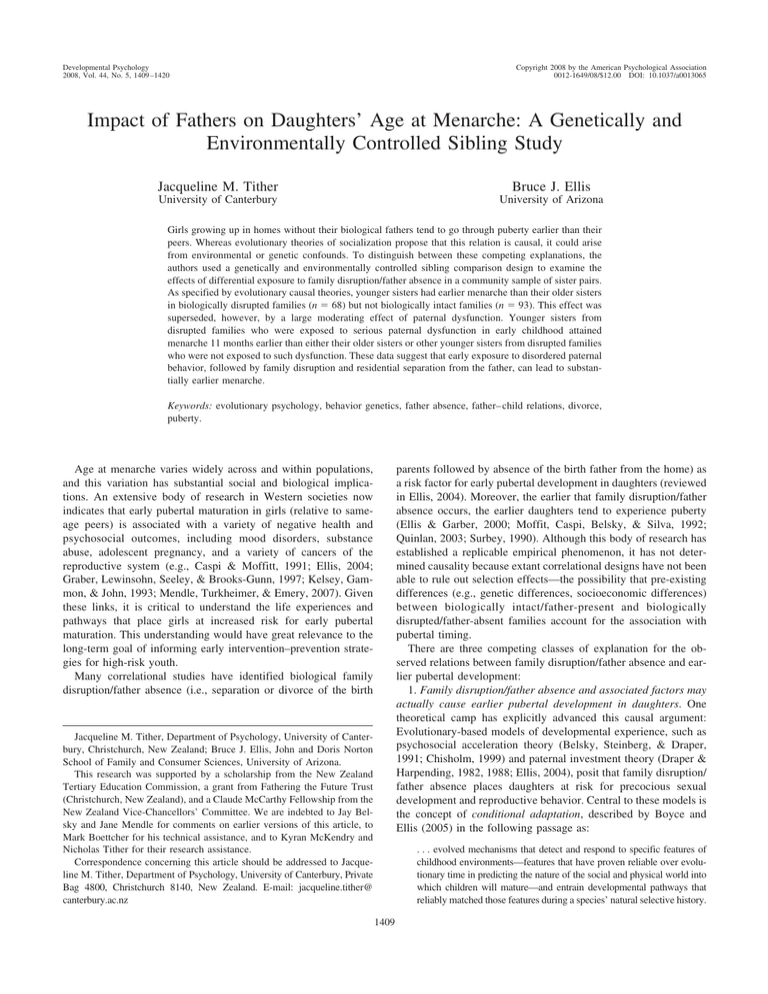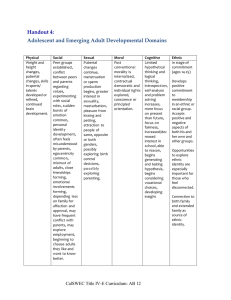Impact of Fathers on Daughters’ Age at Menarche: A Genetically... Environmentally Controlled Sibling Study
advertisement

Developmental Psychology 2008, Vol. 44, No. 5, 1409 –1420 Copyright 2008 by the American Psychological Association 0012-1649/08/$12.00 DOI: 10.1037/a0013065 Impact of Fathers on Daughters’ Age at Menarche: A Genetically and Environmentally Controlled Sibling Study Jacqueline M. Tither Bruce J. Ellis University of Canterbury University of Arizona Girls growing up in homes without their biological fathers tend to go through puberty earlier than their peers. Whereas evolutionary theories of socialization propose that this relation is causal, it could arise from environmental or genetic confounds. To distinguish between these competing explanations, the authors used a genetically and environmentally controlled sibling comparison design to examine the effects of differential exposure to family disruption/father absence in a community sample of sister pairs. As specified by evolutionary causal theories, younger sisters had earlier menarche than their older sisters in biologically disrupted families (n ⫽ 68) but not biologically intact families (n ⫽ 93). This effect was superseded, however, by a large moderating effect of paternal dysfunction. Younger sisters from disrupted families who were exposed to serious paternal dysfunction in early childhood attained menarche 11 months earlier than either their older sisters or other younger sisters from disrupted families who were not exposed to such dysfunction. These data suggest that early exposure to disordered paternal behavior, followed by family disruption and residential separation from the father, can lead to substantially earlier menarche. Keywords: evolutionary psychology, behavior genetics, father absence, father– child relations, divorce, puberty. parents followed by absence of the birth father from the home) as a risk factor for early pubertal development in daughters (reviewed in Ellis, 2004). Moreover, the earlier that family disruption/father absence occurs, the earlier daughters tend to experience puberty (Ellis & Garber, 2000; Moffit, Caspi, Belsky, & Silva, 1992; Quinlan, 2003; Surbey, 1990). Although this body of research has established a replicable empirical phenomenon, it has not determined causality because extant correlational designs have not been able to rule out selection effects—the possibility that pre-existing differences (e.g., genetic differences, socioeconomic differences) between biologically intact/father-present and biologically disrupted/father-absent families account for the association with pubertal timing. There are three competing classes of explanation for the observed relations between family disruption/father absence and earlier pubertal development: 1. Family disruption/father absence and associated factors may actually cause earlier pubertal development in daughters. One theoretical camp has explicitly advanced this causal argument: Evolutionary-based models of developmental experience, such as psychosocial acceleration theory (Belsky, Steinberg, & Draper, 1991; Chisholm, 1999) and paternal investment theory (Draper & Harpending, 1982, 1988; Ellis, 2004), posit that family disruption/ father absence places daughters at risk for precocious sexual development and reproductive behavior. Central to these models is the concept of conditional adaptation, described by Boyce and Ellis (2005) in the following passage as: Age at menarche varies widely across and within populations, and this variation has substantial social and biological implications. An extensive body of research in Western societies now indicates that early pubertal maturation in girls (relative to sameage peers) is associated with a variety of negative health and psychosocial outcomes, including mood disorders, substance abuse, adolescent pregnancy, and a variety of cancers of the reproductive system (e.g., Caspi & Moffitt, 1991; Ellis, 2004; Graber, Lewinsohn, Seeley, & Brooks-Gunn, 1997; Kelsey, Gammon, & John, 1993; Mendle, Turkheimer, & Emery, 2007). Given these links, it is critical to understand the life experiences and pathways that place girls at increased risk for early pubertal maturation. This understanding would have great relevance to the long-term goal of informing early intervention–prevention strategies for high-risk youth. Many correlational studies have identified biological family disruption/father absence (i.e., separation or divorce of the birth Jacqueline M. Tither, Department of Psychology, University of Canterbury, Christchurch, New Zealand; Bruce J. Ellis, John and Doris Norton School of Family and Consumer Sciences, University of Arizona. This research was supported by a scholarship from the New Zealand Tertiary Education Commission, a grant from Fathering the Future Trust (Christchurch, New Zealand), and a Claude McCarthy Fellowship from the New Zealand Vice-Chancellors’ Committee. We are indebted to Jay Belsky and Jane Mendle for comments on earlier versions of this article, to Mark Boettcher for his technical assistance, and to Kyran McKendry and Nicholas Tither for their research assistance. Correspondence concerning this article should be addressed to Jacqueline M. Tither, Department of Psychology, University of Canterbury, Private Bag 4800, Christchurch 8140, New Zealand. E-mail: jacqueline.tither@ canterbury.ac.nz . . . evolved mechanisms that detect and respond to specific features of childhood environments—features that have proven reliable over evolutionary time in predicting the nature of the social and physical world into which children will mature—and entrain developmental pathways that reliably matched those features during a species’ natural selective history. 1409







